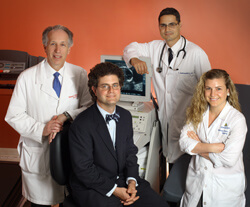Cardiovascular Report
June 19, 2013

In order to provide early, coordinated care for the growing number of patients with diabetes-related vascular and wound complications, Abularrage and colleagues developed a multidisciplinary diabetic foot and wound clinic that enables patients to see three specialists in one visit for consultation, education and treatment.
"Our goal is to catch problems early and intervene in order to prevent hospitalizations and amputations, says Abularrage, the clinic's medical director. "Of course, we also care for patients who present with more advanced, complex problems."
Donna Brown, 53, is one such patient. Even though she was diagnosed with diabetes more than 20 years ago, she says, "I didn't understand it or take it that seriously until I started having a funny feeling in my legs that turned out to be a blockage."
With the lack of blood flow to her right foot, her big toe became gangrenous and required an amputation. Her primary care doctor referred her to the clinic, where she was seen by a team of specialists who could address her foot and vascular problems, help her get her blood sugar under control and provide coordinated care.
"Ms. Brown came to us with wet gangrene, multiple ulcers, and blood sugar levels that were out of control," says Abularrage." "She was exactly the type of patient that our multidisciplinary clinic is designed to help."
Abularrage opened the blockage in her leg with angioplasty to immediately restore blood flow. However, she had a lingering wound in her foot in spite of the angioplasty, multiple debridement procedures, and negative pressure wound therapy at the clinic.
Abularrage enlisted the help of plastic surgeon Justin Sacks, who performed an adjacent tissue transfer to close the wound, as well as multiple skin grafts for Brown's ulcers. Those steps, in combination with bypass surgery to detour the blood around a recurrence in the blockage, allowed her foot to heal.
"Ms. Brown is typical of patients who need the services of all of us-not just vascular surgery but also podiatry, plastic surgery and endocrinology,"
says Abularrage.
Brown says the clinic's endocrinologist, Nestoras Mathioudakis, has helped her understand her disease and learn how to monitor and control her blood sugar.
"When I came in distressed and scared, they really helped me through it. They explained exactly what was going on, told me all of the options and gave me a chance to make up my mind," Brown explains. "I am very grateful for this clinic."
Brown also is pleased with being able to see several specialists in one clinic visit. "Patients like me have a hard time getting around, and this saves us from making multiple trips."
"It's too much to ask them to see different specialists on different days. It delays their care," Abularrage says.
